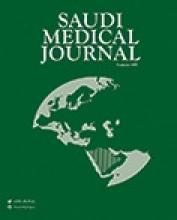Abstract
OBJECTIVES: To determine the prevalence and clinical characteristics of oral bony outgrowths (OBOs); torus palatinus (TP), torus mandibularis (TM), and exostoses in Jordanian dental patients.
METHODS: This cross-sectional study was conducted between November 1 and December 31, 2008 at the University of Jordan Hospital, Amman, Jordan. Clinical examinations of 618 patients (354 men and 264 women), 10-82 years of age, were conducted to determine the presence of OBOs.
RESULTS: There were 239 subjects (38.7%) who had OBOs. Nearly one-third (34.6%) had TP, TM, or both. The prevalence rates were 25.7% for TM, 15.4% for TP, and 14.4% for exostoses. The OBOs were mostly noted in patients in their fifth decade of life, with attrition, clenching, or bruxism. Women had more TP, but gender differences were not statistically significant in cases of TM and exostoses. Most TP were large in size (71.6%), spindle (41.1%), or flat (40%) in shape, and located at the premolar-molar region (45.3%). The TM were mostly medium to large in size (84.9%), bilateral (81.1%), composed of single node (69.2%), and located at the premolar region (65.4%). Of the studied subjects, 7.1% had mandibular buccal exostosis, 10% had maxillary buccal, and 2.4% had palatal exostoses. Statistically significant associations were noticed between the concurrent existence of OBOs.
CONCLUSIONS: A relatively high prevalence of OBOs was noted, and this should be taken into consideration when planning periodontal surgery and prosthodontic treatment.
- Copyright: © Saudi Medical Journal
This is an open-access article distributed under the terms of the Creative Commons Attribution-Noncommercial-Share Alike 3.0 Unported, which permits unrestricted use, distribution, and reproduction in any medium, provided the original work is properly cited.






